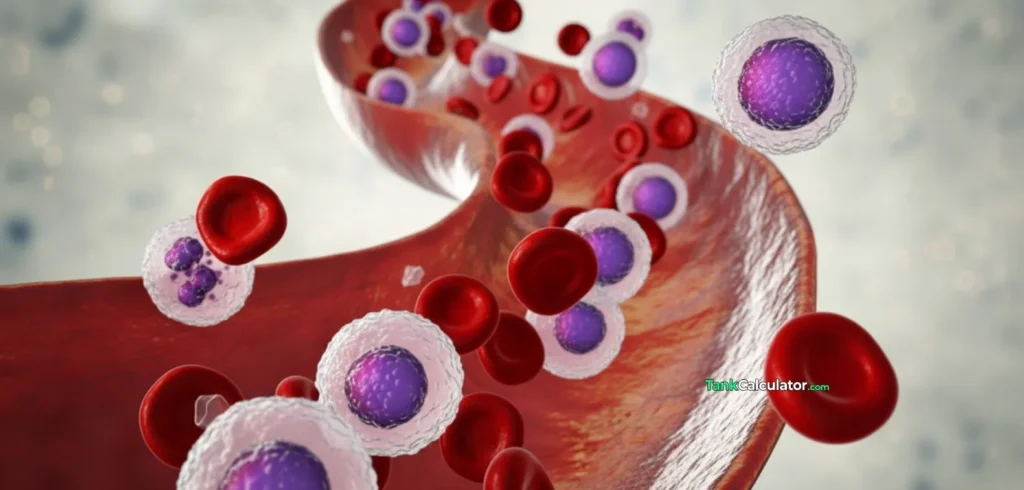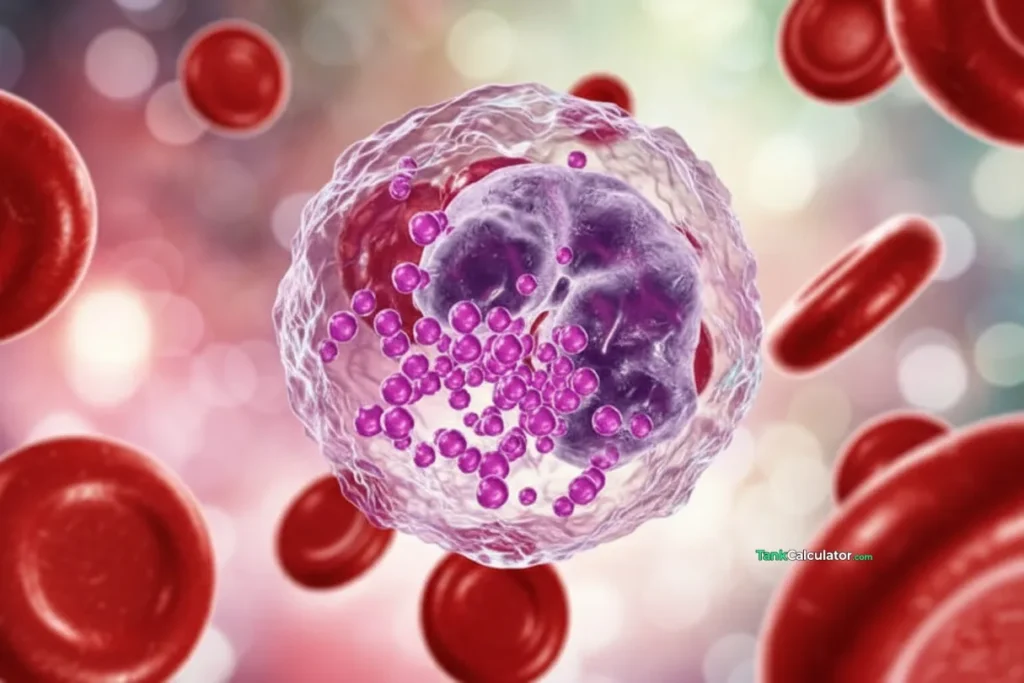To calculate Absolute Basophil Count, enter the following details given below:
Absolute Basophil Count Calculator
Normal Range: 0.01 to 0.1 cells/µL
0.00
cells/µL
Formula:
Absolute Basophil Count = (Basophil Count % / 100) × (WBC Count in cells/µL)
** Disclaimer:** This tool is for educational purposes only. Please consult a healthcare professional for medical advice.
Quick Navigation
What Are Basophils?
When you hear the word basophils, you are talking about one of the least abundant but still important type of white blood cells of body. These mini warriors play several roles in your immune system. Their basophils function includes releasing histamine and heparin which help mediate allergic reactions and prevent excessive blood clotting in body. They also contribute to inflammation and immune responses like: their role of basophils in immune system by signaling and cooperating with other white blood cells when something is off in your body.
Although they make up less than about 1 % of circulating white blood cells, they punch above their weight when it comes to triggering downstream immune effects.

How Long Do Basophils Live?
You might wonder: once basophils are released into the blood, how long do they last? The lifespan of basophils in blood is relatively short. Generally, basophils circulate for only a few days (often 1–2 days) before migrating into tissues or being cleared. Their lifetime in tissues may be somewhat longer under certain conditions, depending on immune activity and signals in the tissue environment.
Because their numbers are low and dynamic, slight changes in production, distribution, or removal can alter their levels noticeably.
What Is Absolute Basophil Count?
When you get a basophil blood test, usually as part of a complete blood count (CBC) with differential, the lab often reports both the percentage of basophils and their absolute count. The absolute basophil count is simply the estimated number of basophils per microliter or per liter of blood rather than just the percentage of total white blood cells that are basophils.
Why is this useful?
Because percentages alone can be misleading
For example: If your total white blood cell (WBC) count is low, even a “normal” basophil percentage could result in a very low absolute basophil number and vice versa.
The absolute count gives a clearer picture.
Basophils Normal Range
Most labs say a normal absolute basophil count is somewhere between:
- 0 to 200 or 300 cells per microliter (μL)
- SI units: 0 to 0.2 – 0.3 × 10⁹ cells per liter (L)
Because lab techniques and differ always refer to the reference range printed in your lab report.
Basophils Absolute Low Count
When the low absolute basophil count it also called basopenia is observed it may hint at underlying conditions. Some causes of low basophils include:
- Acute or severe infections in body
- Use of corticosteroids or certain medications
- Stress physical or emotional
- Overactive thyroid (hyperthyroidism)
- Radiation therapy or bone marrow suppression
As for symptoms of low basophils there often are not direct symptoms just from a low number. Instead, the symptoms usually reflect the reason why it is low symptoms like infections, fatigue and fever. In many cases basopenia by itself is not alarming unless paired with other abnormal counts or clinical signs.
Basophils Absolute High Count
An elevated high absolute basophil count, known as basophilia, suggests your body is producing more basophils than normal. Some causes of high basophils may include:
- Allergic reactions like, hay fever, asthma hives
- Chronic inflammation like, ulcerative colitis, rheumatoid arthritis
- Myeloproliferative disorders like, chronic myeloid leukemia CML
- Hypothyroidism
- Certain infections in body or parasitic diseases
What about symptoms of high basophils? Again, Basophilia itself may not cause symptoms directly. Instead, you may see allergy related signs itching, rashes, swelling or symptoms of an underlying disease e.g. fatigue, weight changes, fever etc. When basophils are significantly elevated, physicians often investigate more serious causes. The condition of too many basophils is sometimes referred to as basophilia.
How to Calculate Absolute Basophil Count manually
If you have your WBC count and basophil percentage you can estimate the absolute basophil count using a straight forward formula. This is also what many online absolute basophil count formula tools (or calculators) do.
Here is how:
- Convert the basophil percentage into a decimal (divide by 100).
- Multiply that decimal by the total WBC count (in cells per microliter or equivalent).
So:
- Absolute Basophil Count (ABC) = WBC count × (Basophil % ÷ 100)
Sometimes you see it as:
- ABC = WBC × basophil fraction
If your WBC is given in 10³/µL, convert it to cells/µL first (i.e. multiply by 1,000) or adjust units accordingly.

Below is a small table summarizing unit conversions you might need:
| WBC Label in Report | Interpretation | Equivalent in cells/µL |
|---|---|---|
| 6.2 (×10³/µL) | 6.2 thousand per µL | 6,200 cells/µL |
| 0.0062 × 10⁹/L | per liter presentation | 6,200 cells/µL |
| cells/µL directly | already in desired unit | no conversion needed |
Calculate ABC Using Our Calculator
Let’s walk step by step:
- Step 1 – Enter Your Basophil %
- Suppose your report shows 0.5 % basophils.
- Type 0.5 into the basophil percentage field.
- Step 2 – Enter Your WBC Count
- If your report says 6.2 × 10³/µL, it means 6,200 cells/µL. Enter 6.2
- Choose the matching unit.
- Step 3 – Select the WBC Unit
- Choose whether your WBC is in cells/µL, 10³/µL or 10⁹/L. The calculator will internally convert.
- Step 4 – Hit “Calculate ABC”
- Using the formula: ABC = (0.5 / 100) × 6200 = 0.005 × 6200 = 31 cells/µL
- Step 5 – See Your Result
- The result appears clearly. In many calculators, it also shows whether your absolute basophil count is Normal, Low, or High, often with color coding. A typical “normal” window might be between 0.01 and 0.1 cells/µL (or similar) depending on the lab’s internal reference.
(Note: the exact “normal band” in calculators may vary, always compare to your lab’s reference.)
Features of Absolute Basophil Count Calculator
Features of Absolute Basophil Count Calculator
- Smart Unit Selection: You don’t have to manually convert units. Enter WBC in whichever format your lab uses (cells/µL, 10³/µL, or 10⁹/L), and the tool adapts.
- User-Friendly Design: Clean layout, responsive for desktop or mobile, intuitive inputs.
- Instant Results: You input just two values (WBC and basophil %), and it computes ABC immediately.
- Clear Status Indicator: It labels the result as Normal / Low / High, often with helpful color cues.
- Reset & Print Options: Want to clear inputs or print your result for your records?
Not many calculators offer those extra buttons. These features make using a basophil calculator quick, accessible and helpful without needing to fiddle with unit conversions manually.
Advantages of Using Absolute Basophil Count Calculator
Why bother using a basophil calculator instead of doing it by hand or eyeballing?
- Speed & Convenience: You avoid manual unit conversion or percentage mistakes.
- Accuracy: The tool ensures proper decimal handling, reducing calculation errors.
- Readability: Instead of fiddling with numbers, you see a neat result: interpretation.
- Educational: It teaches you how absolute counts relate to percentages and WBC.
- Accessibility: If you’re a patient or student, it’s a handy way to check your CBC report.
In short: the benefits of a basophil calculator lie in clarity, speed, and lowering human error. It’s not a substitute for medical judgment but as a quick check, it’s quite useful.
A Few Notes & Caveats
An automated hematology machines and even manual counting can differ in reliability for basophils count so the ABC is an estimate not a perfect measure. Researchers are working on more precise methods like flow cytometry to count basophils more reliably and stability.
Reference ranges vary by age, sex and lab methodology. Always refer to your laboratory’s “normal range” printed on report result.
A slightly abnormal result does not necessarily indicate disease in body. Many factors like; infection, stress, medications can transiently affect basophils. Physicians look at patterns and symptoms, not just one number.
By using an Absolute Basophil Count Calculator, you can easily transform the basophil percentage and WBC from your blood report into a more meaningful and in absolute value. Whether you are interpreting your own labs, learning hematology or comparing values over time, ABC calculator tool can make the process smoother.
Remember: Calculators are only guides, not final diagnoses always discuss abnormal results low or high, with your healthcare provider in light of symptoms and other test findings, kindly visit to your nearly dr’s clinic.
Frequently Asked Questions (FAQ)
Do basophils decrease in pregnancy?
Yes, a slight dip can happen in female body adjusts to support the baby. Usually it is nothing serious.
Can stress cause low basophil count?
Yes. Stress hormones can temporarily lower basophils but levels often bounce back once stress eases.
What is the basophil level for leukemia?
High basophils may appear in some leukemia cases but doctors use multiple tests, not just this number to diagnose.
Can iron deficiency cause basophilia?
Sometimes. Low iron can slightly raise basophil counts but doctors look at your full blood panel to understand the cause.

